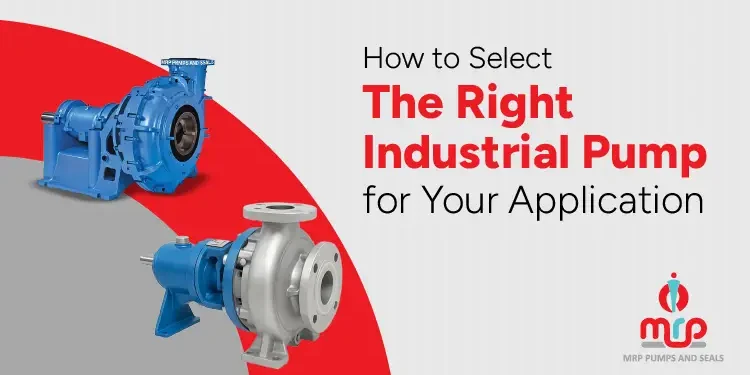Selecting the right industrial pump is a foundational decision that affects the efficiency, safety, uptime, and profitability of your business. From water treatment plants and chemical processing units to oil refineries and paper mills, the right pump will ensure smooth operations while minimizing costly breakdowns and downtime.
This comprehensive, easy-to-use guide—rooted in years of industry expertise and real-world application—will walk you through every stage of industrial pump selection, helping you make an informed and confident choice.
Why Industrial Pump Selection Matters?
Getting the “best fit” pump isn’t about ticking a box—it’s about solving the challenges unique to your facility. A perfectly matched pump guarantee:
- Process Reliability: Reduces unplanned shutdowns and costly downtime
- Safety and Compliance: Prevents leaks, spills, or hazardous incidents
- Cost Control: Minimizes energy use and maintenance, lowering total ownership costs
- Equipment Longevity: Reduces wear, extending pump and system lifespan
The 10-Step Industrial Pump Selection Process
Step 1: Understand Your Application: What Are You Pumping?
The first and most decisive step is to define your process in detail:
Nature of Application: Pumps are used for everything from transferring, dosing, and recirculating fluids to draining wastewater and handling abrasive solids. Each application demands different flow, pressure, and durability parameters.
Industry-Specific Demands:
- Chemical plants prioritize corrosion resistance
- Mining operations need abrasion-resistant slurry pumps
- Food and beverage processes demand sanitary design
- Thermal power plants require heat-tolerant operation
Common Application Examples:
- Pulp and Paper: Moving fibrous slurries with Slurry Pumps or Horizontal Single Stage Side Suction Pumps
- Chemical Processing: Handling acids, solvents, or caustics with Polypropylene Centrifugal Pumps or Chemical Process Pumps
- Textile and Dye Plants: Managing process water, dyes, or effluent using Centrifugal Monoblock Pumps or Vertical Inline Centrifugal Pumps
Pro Tip: Always make a list of all fluids handled, locations where pumping occurs, and process needs before starting your selection.
Step 2: Identify Fluid Characteristics: Why Does Fluid Matter?
Matching a pump to your fluid ensures trouble-free operation, prevents corrosion, blockages, or excessive wear. Key properties to consider:
Chemical Composition: Is your fluid corrosive (acids, caustics, solvents), neutral, or abrasive?
Viscosity:
- Thick, syrupy fluids require Positive Displacement Pumps (like Rotary Gear Pumps or Progressive Cavity Screw Pumps)
- Thin, water-like fluids work well with Centrifugal Pumps
Temperature: High-temperature media (such as thermal oils or hot water) need Air Cooled Pumps, Thermal Hot Oil Pumps, or Water-Cooled Pumps designed for heat resistance.
Presence of Solids: Slurries, mud, or wastewater containing particulates require specialized Slurry Pumps, Sewage Mud Pumps, or Vertical Long Shaft Sump Pumps.
Toxicity or Volatility: Select sealed or glandless pumps if fluid escape poses safety risks.
Industry Insight: Chemical-resistant materials (like polypropylene or stainless steel) are essential for aggressive fluids, and pumps with hardened internals are vital for abrasive slurries.
Step 3: Determine Flow Rate and Pressure Requirements
A correct match for flow and pressure underpins both efficiency and pump longevity. Consider:
Flow Rate (Q): The volume of fluid to be moved per unit time (liters/hour, m³/h, GPM). Both peak and average rates are vital for size selection.
System Head/Pressure: The total pressure or “head” the pump must overcome, factoring in elevation, friction losses in pipes, valves, bends, and equipment.
Variable Demand: Applications with fluctuating demand may need pumps that can be turned down efficiently, such as Centrifugal Process Pumps or Variable Speed Vertical Inline Pumps.
Pro Tip: Over-sizing increases energy costs and shortens pump life; under-sizing leads to process interruptions and rapid burnout. Always use accurate process data.
Step 4: Select Pump Type: Matching Technology to Task
Industrial pumping isn’t one-size-fits-all. Choosing the right pump architecture is essential:
Centrifugal Pumps
How They Work: Convert rotational energy to kinetic energy, moving fluid via centrifugal force.
When to Use: High flow, low to medium viscosity applications (e.g., water, chemicals, clear liquids).
Popular Models: Centrifugal Process Pump, Centrifugal End Suction Pump, Close Coupled Centrifugal Pump, Centrifugal Monoblock Pump.
Positive Displacement Pumps
How They Work: Move fluid by trapping a fixed amount and forcing (displacing) it into the discharge pipe.
Best For: High-viscosity, high-pressure, or metered dosing. Excellent for oils, slurries, and precise injection applications.
Popular Models: High Pressure Triplex Plunger Pump, Metering Plunger Pump, Progressive Cavity Screw Pump, Rotary Gear Pump.
Specialty and Vertical Pumps
- Sump or Wastewater Applications: Vertical Long Shaft Sump Pumps, Sewage Mud Pumps
- Vacuum Creation: Single Stage Liquid Ring Vacuum Pump, Two Stage Liquid Ring Vacuum Pump
- High Temperature: Air Cooled Pump, Thermal Hot Oil Pump, Water Cooled Pump
Get a custom pump selection guide from MRP Pumps’ industry experts →
Step 5: Choose the Right Materials
Pump lifespan and fluid compatibility depend on construction materials:
Metals: Cast iron and mild steel for clear water or light duties, stainless steel/alloy for corrosion and chemical resistance.
Plastics: Polypropylene and advanced polymers offer great chemical compatibility for acid and caustic service in Polypropylene Centrifugal Pumps.
Wear-resistant: Hardened metals or ceramic coatings for abrasive slurries and mining.
Thermal Capability: High-grade metals for pumps facing hot oil, steam, or extreme temperatures.
Consideration: Material selection affects not only chemical compatibility but also cost balance for long-term value.
Step 6: Factor in Installation Environment
Your plant’s conditions shape both pump life and worker safety:
Physical Space: Modular options like Close Coupled Centrifugal Pumps or Vertical Inline Centrifugal Pumps make installation in tight or vertical spaces easy.
Ambient Conditions: If pumps are exposed to outdoor weather, moisture, or chemical vapors, opt for protective coatings and hermetically sealed motors.
Noise/Vibration: Use pumps with low-VIB design or add dampening installations, especially in sensitive environments.
Important: Consider ease of maintenance access and routine service when selecting pump orientation and installation style.
Step 7: Prioritize Energy Efficiency and Lifecycle Costing
Your lowest total cost isn’t the cheapest pump—it’s the most efficient, reliable one. Assess:
Pump Efficiency: High-efficiency models reduce operational power bills.
Drive Systems: Variable speed drives can match output to process needs, cutting both energy and wear.
Spares Availability: Models with low-cost, quickly available parts minimize downtime.
Maintenance Requirements: Feature robust seals, bearings, and easy-access internals to lower maintenance cost and frequency.
Want to cut costs and boost uptime? Contact us for Energy Solutions →
Step 8: Ensure Safety and Compliance
Safety Norms: Chemical, food, and pharma applications demand leak-proof designs, hygienic finishes, and compliance with international standards (ISO, CE, ATEX, etc.).
Environmental Legislation: Emissions control, effluent collection, and spill containment architectures may be required by law.
Process Certification: Pumps in critical services (such as in power or nuclear plants) need third-party certifications and quality documentation.
Step 9: Consider Support and Service Availability
Downtime can cost thousands. Always ensure:
Service Network: Quick on-site support and skilled technical team access.
Parts Supply: Fast, reliable spare parts for urgent breakdowns or preventive maintenance.
System Optimization: Access to support for retrofits, upgrades, or efficiency enhancements across pump lifecycle.
Pump maintenance challenges? MRP Pumps offers full-service support to keep your system run smoothly.
Step 10: Final Selection and Documentation
Document your selection criteria and maintain records for future reference, expansion, or troubleshooting.
Quick Reference: Industrial Pump Types and Applications
| Pump Type | Typical Applications | Special Features/Advantages |
| Centrifugal Process Pump | Water treatment, general plant utility | Robust, simple, efficient for clear/low-viscosity fluids |
| Centrifugal End Suction Pump | Chemical transfer, HVAC, firefighting | Compact, easy to install, suitable for moderate heads |
| Polypropylene Centrifugal Pump | Corrosive chemical transfer | Highly chemical-resistant, lightweight |
| Centrifugal Monoblock Pump | Industrial cooling, irrigation | Compact, low-maintenance, good for clean liquids |
| Close Coupled Centrifugal Pump | Booster systems, high purity applications | Space-saving, easy motor/pump alignment |
| Vertical Inline Centrifugal Pump | Tall or tight installations, process cooling | Minimal footprint, smooth vertical flow |
| Horizontal Single Stage Side Suction | Salt processing, sugar, paper, textile | Handles fibrous slurries, large clearances |
| Air Cooled Pump / Thermal Hot Oil Pump | Boilers, thermic fluid heaters | Withstands high temps, efficient air or water cooling |
| Slurry Pump / Sewage Mud Pump | Mining, ceramics, effluent, wastewater | Tough, abrasion-resistant, large solids handling |
| High Pressure Multistage / Plunger | RO, boiler feed, testing, high pressure cleaning | Multi-stage for high head or triplex plunger for precision and pressure |
| Metering/Dosing (Diaphragm/Plunger) | Fertilizer, chemical dosing, pharma factories | Accurate, leak-free, ideal for small, precise volumes |
| Vacuum Pumps (Single/Two Stage) | Evacuation, filtration, degassing | Cuts down process air content, supports separation processes |
| Rotary Gear / Progressive Cavity | Oil transfer, lubricants, heavy viscous fluids | Ideal for thick, shear-sensitive or starchy liquids |
| Vertical Long Shaft Sump Pump | Deep pits, wastewater sumps, stormwater | Handles submersion, robust construction |
Industry-Specific Selection Tips
1. Chemical Industry
Corrosion resistance and leak-proof systems are essential. Polypropylene Centrifugal Pumps and sealed Metering/Dosing Pumps prevent leaks and withstand aggressive acids or caustics, making them ideal for chemical dosing or transfer.
2. Oil & Gas
High-pressure Triplex Plunger Pumps, Horizontal Multistage Pumps, and Rotary Gear Pumps handle hydrocarbons, lubricants, and oil wastes, offering robust sealing against leaks.
3. Mining & Construction
Abrasion-resistant Slurry Pumps, Sewage Mud Pumps, and Sump Pumps withstand solids, slurry, and heavy contaminants.
4. Water and Wastewater
Centrifugal Monoblock, End Suction, and Vertical Inline Pumps are highly favored for water supply, distribution, or treatment.
5. Power & Thermal Plants
Air Cooled, Thermal Hot Oil, and Water-Cooled Pumps safely manage circulation in thermic fluid systems with minimal external cooling or heat loss.
6. Textiles & Paper
Horizontal Side Suction Pumps and Progressive Cavity Screw Pumps efficiently move fibrous, high-solid-content liquids.
Conclusion
Selecting the right industrial pump isn’t a one-time event—it’s an ongoing, strategic process informed by your application, fluid, flow, pressure, system design, site environment, and need for support. By paying attention to each factor outlined above, operations managers and engineers can drastically boost productivity, reduce downtime, and future-proof their investment in core plant systems.
For the widest range of process-specific centrifugal, chemical, slurry, and specialty pumps—along with technical consultation, customization, and lifecycle support—partnering with an experienced, trusted supplier ensures a smooth, successful outcome.
Ready to optimize your plant’s efficiency and reliability?
Get the full range of industrial pumps engineered for your process—from centrifugal and chemical pumps to custom solutions—all backed by over 15 years of expertise. Request a personalized consultation or get a customized quote for your industry needs.
Contact us today to discuss your requirements or to contact our technical team for expert support.
Frequently Asked Questions
Measure the amount of fluid you need to move per unit time, considering peak and average process demand. Use plant design specs, process data, or flow meters—account for system losses and expansion needs.
No. Centrifugal pumps are great for clean, low-viscosity fluids (like water and light chemicals). For viscous, abrasive, or pulsating applications, consider positive displacement, slurry, or specialty pump designs.
Whenever your process handles acids, caustics, salts, organic solvents, or other aggressive media, use pumps built from corrosion-resistant metals or plastics (e.g., polypropylene centrifugal, chemical process pumps).
Regular inspections, lubrication, seal replacement, and periodic performance checks are vital. Select pumps with easy access to spares and local support for the longest, smoothest service.
Choose modular, upgradeable designs from vendors with robust support. Consult experts for evolving fluid, process, or system requirements—don’t compromise on core criteria like flow, pressure, and material compatibility.




